Essential oil of Ruta chalepensis L. from Djibouti: Chemical Analysis and Modeling of In Vitro Anticancer Profiling
Abstract
1. Introduction
2. Material and Methods
2.1. Origin of the R. chalepensis L. Plant
2.2. Essential Oil: Extraction and Chemical Composition
2.3. Cytotoxicity Activity
2.4. Statistical Analysis
3. Results
- Tests for cytotoxic activity are independent.
- Efficacy was coded according to the obtained IC50 values (Table 4).
- Group 1: the effectiveness of the essential oil against cancer cell lines U2OS, NCI-N87, MRC-5, MIA-Paca2, JIMT-T1, and HEK293.
- Group 2: the effectiveness of the active substances Vinblastine and Combrestatin A4 against the cancer cell lines U87-MG, K562, and HCT116.
- Group 3: the effectiveness of the active substances Doxorubicin and Monomethyl Auristatin E against the cancer cell lines RT4, PC3, A549, and A2780.
4. Discussion
5. Conclusions
Author Contributions
Funding
Informed Consent Statement
Data Availability Statement
Conflicts of Interest
References
- Issac, J.; Raveendran, P.S.; Das, A.V. RFX1: A promising therapeutic arsenal against cancer. Cancer Cell Int. 2021, 21, 253. [Google Scholar] [CrossRef] [PubMed]
- Abdoul-Latif, F.M.; Ainane, A.; Aboubaker, I.H.; Ahmed, N.M.; Ainane, T. Effectiveness of a diet for type 2 diabetics based on vegetables and fruits of the Cucurbitaceae family. J. Anal. Sci. Appl. Biotechnol. 2021, 3, 107–113. [Google Scholar]
- Banerjee, D.; Cieslar-Pobuda, A.; Zhu, G.H.; Wiechec, E.; Patra, H.K. Adding nanotechnology to the metastasis treatment arsenal. Trends Pharmacol. Sci. 2019, 40, 403–418. [Google Scholar] [CrossRef]
- Bourne, R.; Steinmetz, J.D.; Flaxman, S.; Briant, P.S.; Taylor, H.R.; Resnikoff, S.; Tareque, M.I. Trends in prevalence of blindness and distance and near vision impairment over 30 years: An analysis for the Global Burden of Disease Study. Lancet Glob. Health 2021, 9, e130–e143. [Google Scholar] [CrossRef]
- Ainane, T. Moroccan traditional treatment for fever and influenza, similar to symptoms of coronavirus COVID-19 disease: Mini Review. J. Anal. Sci. Appl. Biotechnol. 2020, 2, 1–3. [Google Scholar]
- Rockers, P.C.; Laing, R.O.; Ashigbie, P.G.; Onyango, M.A.; Mukiira, C.K.; Wirtz, V.J. Effect of Novartis Access on availability and price of non-communicable disease medicines in Kenya: A cluster-randomised controlled trial. Lancet Glob. Health 2019, 7, e492–e502. [Google Scholar] [CrossRef]
- Porter, B.; Arthur, A.; Savva, G.M. How do potentially inappropriate medications and polypharmacy affect mortality in frail and non-frail cognitively impaired older adults? A cohort study. BMJ Open 2019, 9, e026171. [Google Scholar] [CrossRef]
- Attahar, W.; Mohamed Abdoul-Latif, F.; Mohamed, J.; Ainane, A.; Ainane, T. Antimicrobial and antioxidant activities of Trigonella foenum-graecum essential oil from the region of settat (Morocco). Pharmacologyonline 2021, 2, 434–442. [Google Scholar]
- Ouassil, M.; Mohamed Abdoul-Latif, F.; Attahar, W.; Ainane, A.; Ainane, T. Chemical composition of bay laurel and rosemary essential oils from morocco and their antifungal activity against fusarium strains. Pharmacologyonline 2021, 2, 426–433. [Google Scholar]
- Talbi, M.; Ainane, T.; Boriky, D.; Bennani, L.; Blaghen, M.; Elkouali, M. Antibacterial activity of Eudesmanolide compounds isolated from medicinal plant Artemisia herba-alba. J. Mater. Environ. Sci. 2015, 6, 2125–2128. [Google Scholar]
- Ainane, T.; Abourriche, A.; Kabbaj, M.; Elkouali, M.; Bennamara, A.; Charrouf, M.; Lemrani, M. Biological activities of extracts from seaweed Cystoseira tamariscifolia: Antibacterial activity, antileishmanial activity and cytotoxicity. J. Chem. Pharm. Res 2014, 6, 607–611. [Google Scholar]
- Obame-Engonga, L.C.; Abdoul-Latif, F.M.; Ondo, J.P.; Sima-Obiang, C.; Ngoua-Meye-Misso, R.L.; Traoré, A.; Koudou, J. Phytochemical screening, antioxidant and antibacterial activities of Guibourtia ehie and Syzygium rowlandii medicinal plants from Gabon. Int. J. Curr. Res. 2017, 9, 56354–56360. [Google Scholar]
- Elmi, A.; Spina, R.; Abdoul-Latif, F.; Yagi, S.; Fontanay, S.; Risler, A.; Laurain-Mattar, D. Rapid screening for bioactive natural compounds in Indigofera caerulea Rox fruits. Ind. Crops Prod. 2018, 125, 123–130. [Google Scholar] [CrossRef]
- Abdoul-Latif, F.M.; Elmi, A.; Merito, A.; Nour, M.; Risler, A.; Ainane, A.; Ainane, T. Essential Oils of Tagetes minuta and Lavandula coronopifolia from Djibouti: Chemical Composition, Antibacterial Activity and Cytotoxic Activity against Various Human Cancer Cell Lines. Int. J. Plant Biol. 2022, 13, 315–329. [Google Scholar] [CrossRef]
- Mohamed Abdoul-Latif, F.; Elmi, A.; Merito, A.; Nour, M.; Risler, A.; Ainane, A.; Ainane, T. Chemical Analysis of Essential Oils of Cymbopogon schoenanthus (L.) Spreng. and Nepeta azurea R. Br. ex Benth from Djbouti, In-Vitro Cytotoxicity against Cancer Cell Lines and Antibacterial Activities. Appl. Sci. 2022, 12, 8699. [Google Scholar] [CrossRef]
- Mohamed Abdoul-Latif, F.; Elmi, A.; Merito, A.; Nour, M.; Risler, A.; Ainane, A.; Ainane, T. Essential Oils of Ocimum basilicum L. and Ocimum americanum L. from Djibouti: Chemical Composition, Antimicrobial and Cytotoxicity Evaluations. Processes 2022, 10, 1785. [Google Scholar] [CrossRef]
- Abdoul-Latif, F.M.; Aouled Aden, S.; Abdoulkarim Omar, D.; Mohamed Abdoul-Latif, T.; Ainane, T. Bacterial infections in hemodialysis patients at peltier hospital, Djibouti. Pharmacologyonline 2021, 3, 877–882. [Google Scholar]
- Elmi, A.; Spina, R.; Risler, A.; Philippot, S.; Mérito, A.; Duval, R.E.; Abdoul-Latif, F.M.; Laurain-Mattar, D. Evaluation of antioxidant and antibacterial activities, cytotoxicity of Acacia seyal Del bark extracts and isolated compounds. Molecules 2020, 25, 2392. [Google Scholar] [CrossRef]
- AbouAitah, K.; Lojkowski, W. Nanomedicine as an Emerging Technology to Foster Application of Essential Oils to Fight Cancer. Pharmaceuticals 2022, 15, 793. [Google Scholar] [CrossRef]
- Pavithra, P.S.; Mehta, A.; Verma, R.S. Essential oils: From prevention to treatment of skin cancer. Drug Discov. Today 2019, 24, 644–655. [Google Scholar] [CrossRef]
- Ainane, A.; Khammour, F.; El Kouali, M.; Talbi, M.; Oussaid, A.; Lemhidi, A.; Ainane, T. Evaluation of the toxicity of the essential oils of certain mints grown in the region of Settat (Morocco): Mentha piperita, Mentha pulegium and Mentha spicata against, Sitophilus Granarius, Sitophilus Oryzae and Sitophilus Zeamais. J. Anal. Sci. Appl. Biotechnol. 2019, 1, 1–10. [Google Scholar]
- Ainane, T.; Elkouali, M.H.; Ainane, A.; Talbi, M. Moroccan traditional fragrance based essential oils: Preparation, composition and chemical identification. Der Pharma Chem. 2014, 6, 84–89. [Google Scholar]
- Zu, Y.; Yu, H.; Liang, L.; Fu, Y.; Efferth, T.; Liu, X.; Wu, N. Activities of ten essential oils towards Propionibacterium acnes and PC-3, A-549 and MCF-7 cancer cells. Molecules 2010, 15, 3200–3210. [Google Scholar] [CrossRef] [PubMed]
- Kaigongi, M.M.; Lukhoba, C.W.; Yaouba, S.; Makunga, N.P.; Githiomi, J.; Yenesew, A. In vitro antimicrobial and antiproliferative activities of the root bark extract and isolated chemical constituents of Zanthoxylum paracanthum Kokwaro (Rutaceae). Plants 2020, 9, 920. [Google Scholar] [CrossRef] [PubMed]
- Raju, R.; Singh, A.; Reddell, P.; Münch, G. Anti-inflammatory activity of prenyl and geranyloxy furanocoumarins from Citrus garrawayi (Rutaceae). Phytochem. Lett. 2018, 27, 197–202. [Google Scholar] [CrossRef]
- Shahrajabian, M.H. A Candidate for Health Promotion, Disease Prevention and Treatment, Common Rue (Ruta graveolens L.), an Important Medicinal plant in Traditional Medicine. Curr. Rev. Clin. Exp. Pharmacol. 2022. [Google Scholar] [CrossRef] [PubMed]
- Shchérazade OS, F.; Pétronille, A.Z.; Joseph, F.K.Y.; Georges, A. Study of the analgesic effect of the aqueous extract of the leaves of Citrus aurantifolia (Rutaceae) in mice. GSC Biol. Pharm. Sci. 2021, 14, 207–214. [Google Scholar] [CrossRef]
- Rethy, B.; Zupko, I.; Minorics, R.; Hohmann, J.; Ocsovszki, I.; Falkay, G. Investigation of cytotoxic activity on human cancer cell lines of arborinine and furanoacridones isolated from Ruta graveolens. Planta Med. 2007, 73, 41–48. [Google Scholar] [CrossRef]
- Licata, A.; Licata, E.; Vanella, A.; Malaguarnera, M. Oxidative profile in patients with colon cancer: Effects of Ruta chalepensis L. Eur. Rev. Med. Pharmacol. Sci. 2011, 15, 181–191. [Google Scholar]
- Khlifi, D.; Sghaier, R.M.; Amouri, S.; Laouini, D.; Hamdi, M.; Bouajila, J. Composition and anti-oxidant, anti-cancer and anti-inflammatory activities of Artemisia herba-alba, Ruta chalpensis L. and Peganum harmala L. Food Chem. Toxicol. 2013, 55, 202–208. [Google Scholar] [CrossRef]
- Günaydin, K.; Savci, S. Phytochemical studies on Ruta chalepensİs (LAM.) lamarck. Nat. Prod. Res. 2005, 19, 203–210. [Google Scholar] [CrossRef]
- Ainane, A.; Mohamed Abdoul-Latif, F.; Mohamed Abdoul-Latif, T.; Ainane, T. Evaluation of biological activities of two essential oils as a safe environmental bioinsecticides: Case of Eucalyptus globulus and Rosmarinus officinalis. Przegląd Naukowy. Inżynieria I Kształtowanie Sr. 2020, 29, 544–556. [Google Scholar] [CrossRef]
- Shybat, Z.L.; Mohamed Abdoul-Latif, F.; Mohamed, J.; Ainane, A.; Ainane, T. Antifungal activity of the essential oil of morrocan myrtle (Myrtus communis L.): Application in agriculture. Pharmacologyonline 2021, 2, 485–491. [Google Scholar]
- Soussi, M.A.; Provot, O.; Bernadat, G.; Bignon, J.; Desravines, D.; Dubois, J.; Alami, M. IsoCombretaQuinazolines: Potent cytotoxic agents with antitubulin activity. ChemMedChem 2015, 10, 1392–1402. [Google Scholar] [CrossRef] [PubMed]
- Ainane, A.; Abdoul-Latif, F.M.; Mohamed, J.; Attahar, W.; Ouassil, M.; Shybat, Z.L.; Ainane, T. Behaviour desorption study of the essential oil of Cedrus atlantica in a porous clay versus insecticidal activity against Sitophilus granarius: Explanation of the phenomenon by statistical studies. Int. J. Metrol. Qual. Eng. 2021, 12, 1–12. [Google Scholar] [CrossRef]
- Gali, L.; Bedjou, F. Antioxidant and anticholinesterase effects of the ethanol extract, ethanol extract fractions and total alkaloids from the cultivated R. chalepensis L. S. Afr. J. Bot. 2019, 120, 163–169. [Google Scholar] [CrossRef]
- Verzera, V.; Mondello, L.; Ragusa, S.; Dugo, G. Essential oil from leaves of typical Mediterranean plants. Note II Ruta chalepensis L. Essenze E Deriv. Agrum. 2000, 70, 207–210. [Google Scholar]
- Rustaiyan, A.; Khossravi, M.; Sultani-Lotfabadi, F.; Yari, M.; Masoudi, S.; Monfared, A. Constituents of the essential oil of R. chalepensis L. from Iran. J. Essent. Oil Res. 2002, 14, 378–379. [Google Scholar] [CrossRef]
- Baser KH, C.; Özek, T.; Beis, S.H. Constituents of the essential oil of R. chalepensis L. from Turkey. J. Essent. Oil Res. 1996, 8, 413–414. [Google Scholar] [CrossRef]
- Akkari, H.; Ezzine, O.; Dhahri, S.; B’chir, F.; Rekik, M.; Hajaji, S.; Gharbi, M. Chemical composition, insecticidal and in vitro anthelmintic activities of R. chalepensis L. (Rutaceae) essential oil. Ind. Crops Prod. 2015, 74, 745–751. [Google Scholar] [CrossRef]
- Abdoul-latif, F.M.; Ainane, A.; Abdoul-latif, T.M.; Ainane, T. Chemical study and evaluation of insectical properties of African Lippia citriodora essential oil. J. Biopestic. 2020, 13, 119–126. [Google Scholar]
- Gharby, S.; Asdadi, A.; Ibourki, M.; Hamdouch, A.; Ainane, T.; Hassani, L.A.I. Chemical characterization of the essential oil from aerial parts of Lavandula rejdalii Upson & Jury, a medicinal plant endemic to Morocco. J. Essent. Oil Bear. Plants 2020, 23, 1422–1427. [Google Scholar]
- Owen, L.; Laird, K.; Wilson, P.B. Structure-activity modelling of essential oils, their components, and key molecular parameters and descriptors. Mol. Cell. Probes 2018, 38, 25–30. [Google Scholar] [CrossRef]
- Leiherer, A.; Ślefarska, D.; Leja, M.; Heinzle, C.; Mündlein, A.; Kikuste, I.; Mochalski, P. The volatilomic footprints of human HGC-27 and CLS-145 gastric cancer cell lines. Front. Mol. Biosci. 2021, 7, 607904. [Google Scholar] [CrossRef] [PubMed]
- Mahmoud, E.A.; Elansary, H.O.; El-Ansary, D.O.; Al-Mana, F.A. Elevated bioactivity of Ruta graveolens against cancer cells and microbes using seaweeds. Processes 2020, 8, 75. [Google Scholar] [CrossRef]
- Lou, Y.; Guo, Z.; Zhu, Y.; Kong, M.; Zhang, R.; Lu, L.; Wu, J. Houttuynia cordata Thunb. and its bioactive compound 2-undecanone significantly suppress benzo (a) pyrene-induced lung tumorigenesis by activating the Nrf2-HO-1/NQO-1 signaling pathway. J. Exp. Clin. Cancer Res. 2019, 38, 242. [Google Scholar] [CrossRef]
- Villa-Ruano, N.; Pacheco-Hernández, Y.; Zárate-Reyes, J.A.; Cruz-Durán, R.; Lozoya-Gloria, E. Volatile composition and biological activities of the leaf essential oil from Zanthoxylum limoncello grown in Oaxaca, México. Chem. Biodivers. 2019, 16, e1800498. [Google Scholar] [CrossRef]
- Boehme, A.K.; Noletto, J.A.; Haber, W.A.; Setzer, W.N. Bioactivity and chemical composition of the leaf essential oils of Zanthoxylum rhoifolium and Zanthoxylum setulosum from Monteverde, Costa Rica. Nat. Prod. Res. 2008, 22, 31–36. [Google Scholar] [CrossRef]
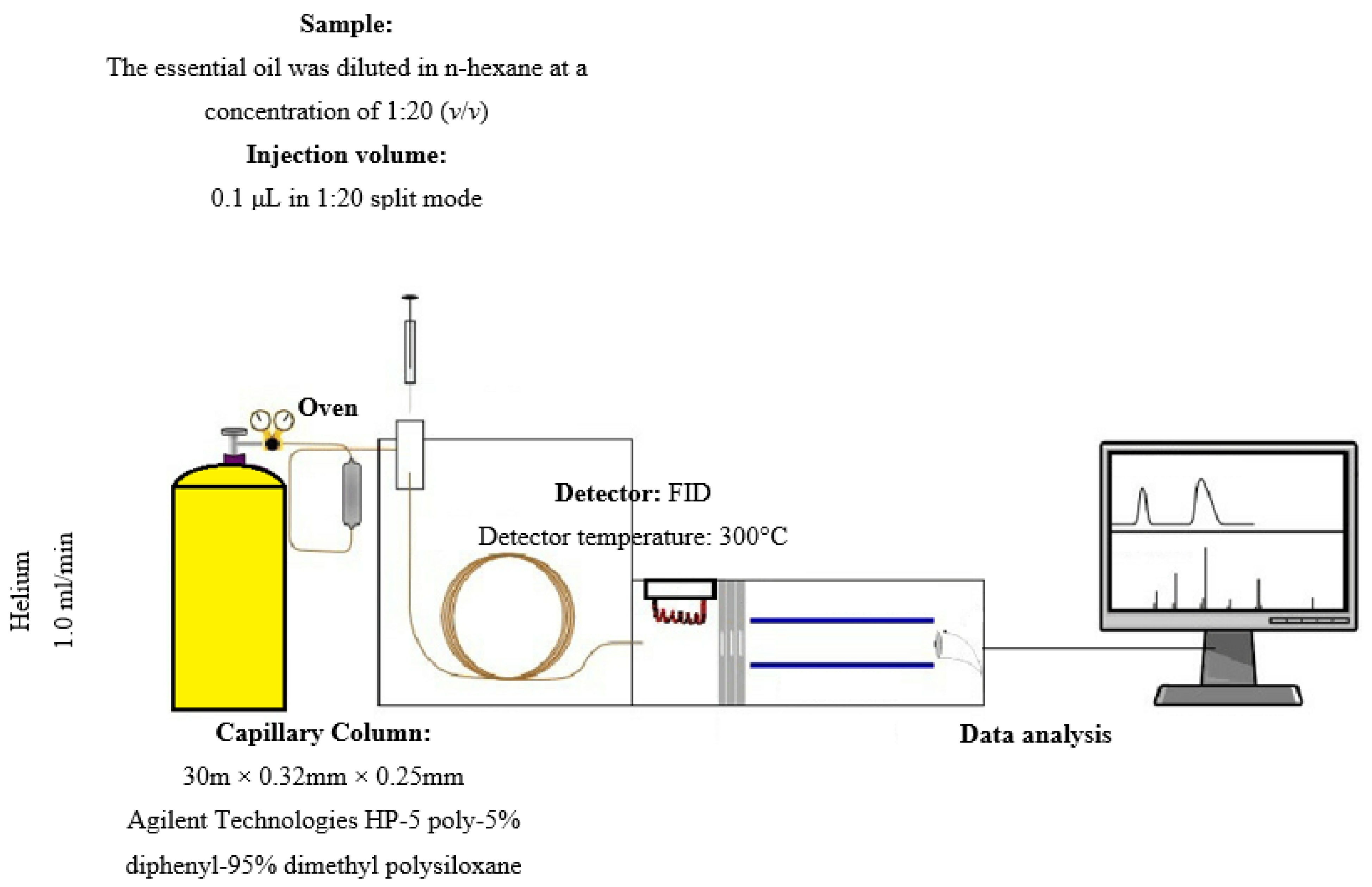
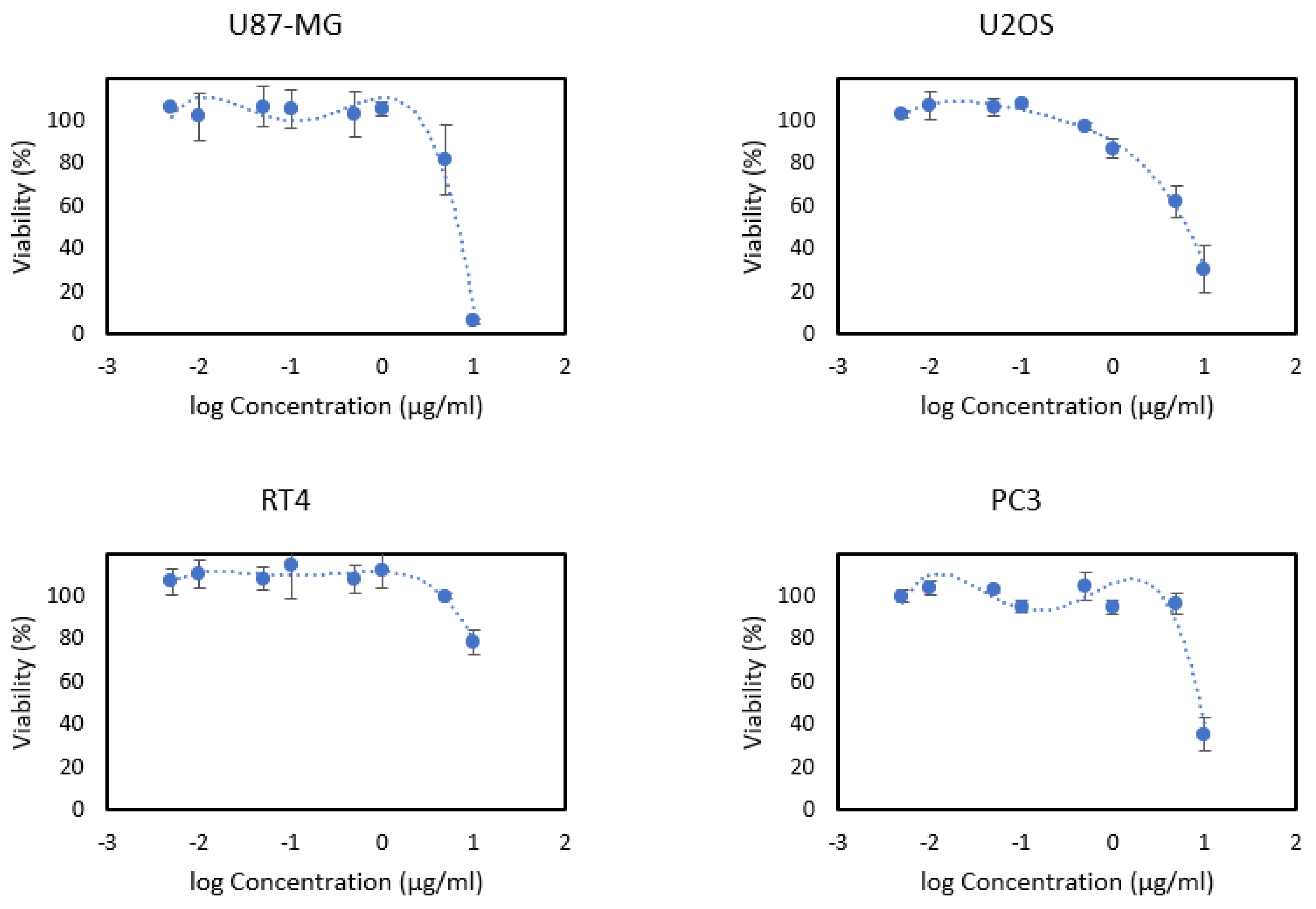

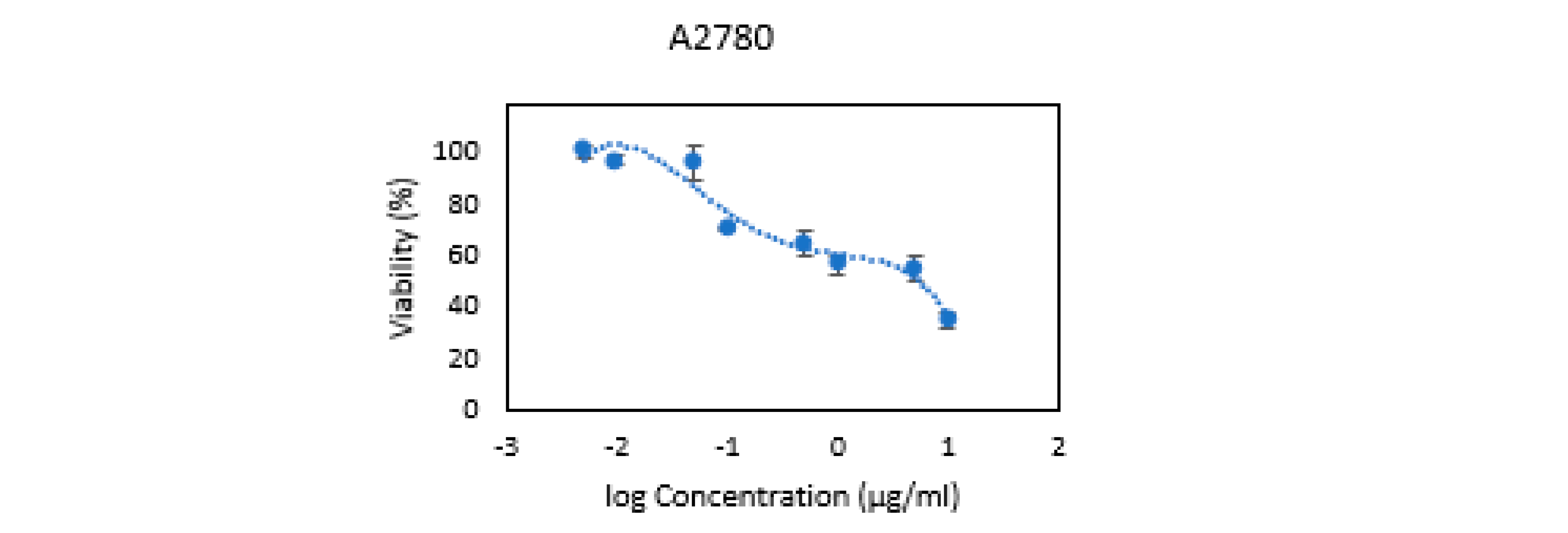
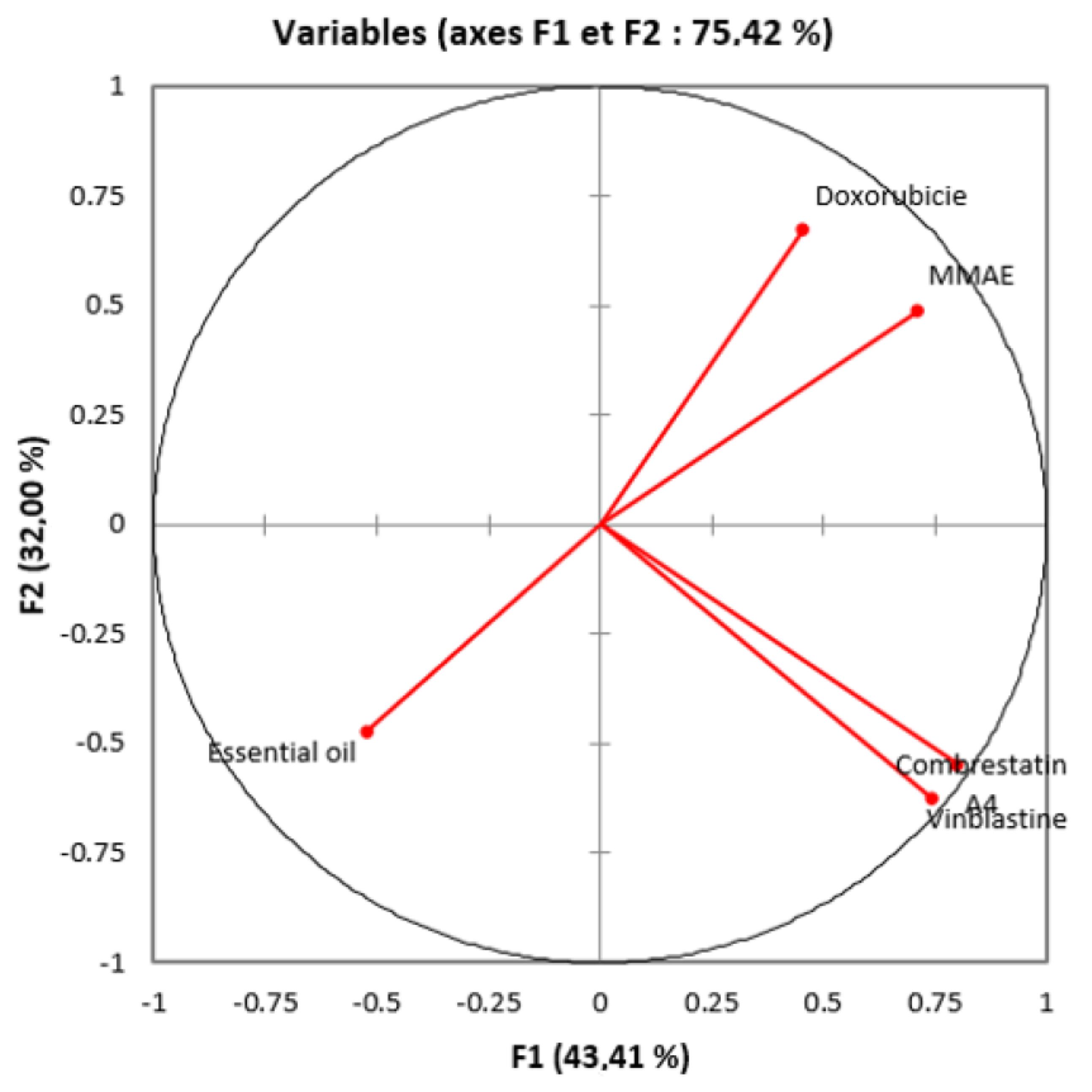
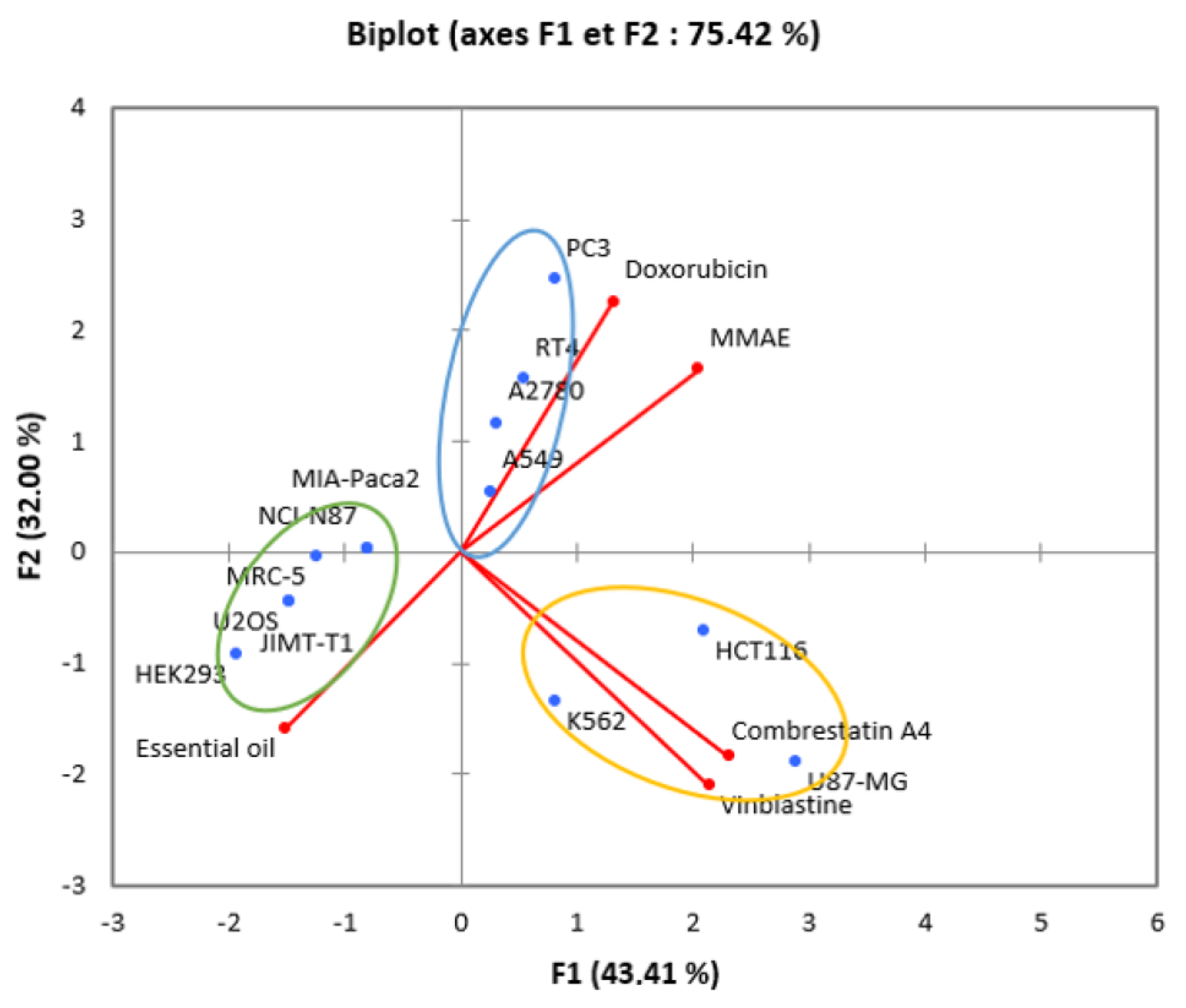
| Concentration (µg/mL) | [0; 1] | [1; 5] | [5; 10] | [10; 20] | [20; 100] | >100 |
|---|---|---|---|---|---|---|
| Code | 5 | 4 | 3 | 2 | 1 | 0 |
| Pic | RT | Compounds | Relative Percentage (%) |
|---|---|---|---|
| 1 | 8.57 | 2-nonanone | 2.8 |
| 2 | 9.52 | Cyclohexene, 3,4-diethenyl-3-methyl- | 1.0 |
| 3 | 10.5 | 2-decanone | 0.8 |
| 4 | 10.82 | Octyl acetate | 17.3 |
| 5 | 11.55 | Piperitone | 0.4 |
| 6 | 11.92 | Chloromethyl octyl ether | 0.2 |
| 7 | 12.13 | 2-undecanone | 51.3 |
| 8 | 12.26 | 2-undecanonol | 1.9 |
| 9 | 12.38 | Stearic acid | 0.3 |
| 10 | 12.67 | 2-acetoxytridecane | 1.0 |
| 11 | 13.15 | 2-dodecanone | 2.8 |
| 12 | 13.68 | 1-Methyl-2-decalone | 0.4 |
| 13 | 13.93 | Cis-caryophyllene | 1.1 |
| 14 | 14.02 | 2-acetoxytetradecane | 7.1 |
| 15 | 14.49 | Bicyclosesquiphellandrene | 0.3 |
| 16 | 14.58 | 5-ketobornyl acetate | 0.6 |
| 17 | 14.74 | Germacrene D | 0.9 |
| 18 | 14.9 | 2-tridecanone | 1.0 |
| 19 | 15.59 | Β- elemol | 1.2 |
| 20 | 15.71 | Nerolidol | 0.3 |
| 21 | 16.03 | Caryophyllene oxide | 0.9 |
| 22 | 16.41 | Cubenol | 0.5 |
| 23 | 16.72 | Τ-cadinol | 0.1 |
| 24 | 16.97 | Viridiflorol | 0.4 |
| 25 | 17.05 | 3-Heptenoic acid, 7-phenyl-, ethyl ester, | 1.8 |
| 26 | 18.63 | Dihydrosafrol | 2.1 |
| 27 | 18.74 | Piperonyl acetone | 0.4 |
| 28 | 21.57 | 3-Methyl-2-butenoic acid, cyclobutyl ester | 1.0 |
| Total (%) | 99.9 | ||
| Cell Line | Essential Oil | Vinblastine | Doxorubicin | Combrestatin A4 | MMAE |
|---|---|---|---|---|---|
| U87-MG | 6.03 ± 0.49 | 2.00 ± 0.04 | 99.61 ± 2.34 | 9.00 ± 0.50 | 0.21 ± 0.03 |
| U2OS | 5.45 ± 0.76 | - | - | - | - |
| RT4 | >100 | - | 36.29 ± 1.20 | - | 0.50 ± 0.01 |
| PC3 | 8.97 ± 0.17 | - | 2.09 ± 0.03 | 0.36 ± 0.03 | |
| NCI-N87 | 2.31 ± 1.28 | - | - | - | 1.65 ± 0.07 |
| MRC-5 | 7.85 ± 0.13 | - | 39.88 ± 1.22 | - | - |
| MIA-Paca2 | 4.84 ± 0.04 | - | - | - | 4.36 ± 0.2 |
| K562 | 3.08 ± 0.59 | 20.00 ± 0.12 | - | 5.00 ± 0.30 | 3.12 ± 0.2 |
| JIMT-T1 | 6.66 ± 0.15 | - | - | - | - |
| HEK293 | 1.39 ± 0.27 | - | - | - | - |
| HCT116 | >100 | 35.00 ± 0.84 | - | 2.00 ± 0.10 | 2.07 ± 0.02 |
| A549 | 8.22 ± 0.73 | - | 56.60 ± 0.84 | 20.00 ± 0.10 | 0.46 ± 0.05 |
| A2780 | >100 | - | - | - | 0.45 ± 0.01 |
| Cell Line | Essential Oil | Vinblastine | Doxorubicin | Combrestatin A4 | MMAE |
|---|---|---|---|---|---|
| U87-MG | 3 | 4 | 1 | 3 | 5 |
| U2OS | 3 | 0 | 0 | 0 | 0 |
| RT4 | 0 | 0 | 1 | 0 | 5 |
| PC3 | 3 | 0 | 5 | 0 | 5 |
| NCI-N87 | 4 | 0 | 0 | 0 | 4 |
| MRC-5 | 3 | 0 | 1 | 0 | 0 |
| MIA-Paca2 | 4 | 0 | 0 | 0 | 4 |
| K562 | 4 | 1 | 0 | 3 | 4 |
| JIMT-T1 | 3 | 0 | 0 | 0 | 0 |
| HEK293 | 5 | 0 | 0 | 0 | 0 |
| HCT116 | 0 | 1 | 0 | 4 | 4 |
| A549 | 3 | 0 | 1 | 1 | 5 |
| A2780 | 0 | 0 | 0 | 0 | 5 |
Publisher’s Note: MDPI stays neutral with regard to jurisdictional claims in published maps and institutional affiliations. |
© 2022 by the authors. Licensee MDPI, Basel, Switzerland. This article is an open access article distributed under the terms and conditions of the Creative Commons Attribution (CC BY) license (https://creativecommons.org/licenses/by/4.0/).
Share and Cite
Abdoul-Latif, F.M.; Elmi, A.; Merito, A.; Nour, M.; Risler, A.; Ainane, A.; Bignon, J.; Ainane, T. Essential oil of Ruta chalepensis L. from Djibouti: Chemical Analysis and Modeling of In Vitro Anticancer Profiling. Separations 2022, 9, 387. https://doi.org/10.3390/separations9120387
Abdoul-Latif FM, Elmi A, Merito A, Nour M, Risler A, Ainane A, Bignon J, Ainane T. Essential oil of Ruta chalepensis L. from Djibouti: Chemical Analysis and Modeling of In Vitro Anticancer Profiling. Separations. 2022; 9(12):387. https://doi.org/10.3390/separations9120387
Chicago/Turabian StyleAbdoul-Latif, Fatouma Mohamed, Abdirahman Elmi, Ali Merito, Moustapha Nour, Arnaud Risler, Ayoub Ainane, Jérôme Bignon, and Tarik Ainane. 2022. "Essential oil of Ruta chalepensis L. from Djibouti: Chemical Analysis and Modeling of In Vitro Anticancer Profiling" Separations 9, no. 12: 387. https://doi.org/10.3390/separations9120387
APA StyleAbdoul-Latif, F. M., Elmi, A., Merito, A., Nour, M., Risler, A., Ainane, A., Bignon, J., & Ainane, T. (2022). Essential oil of Ruta chalepensis L. from Djibouti: Chemical Analysis and Modeling of In Vitro Anticancer Profiling. Separations, 9(12), 387. https://doi.org/10.3390/separations9120387








